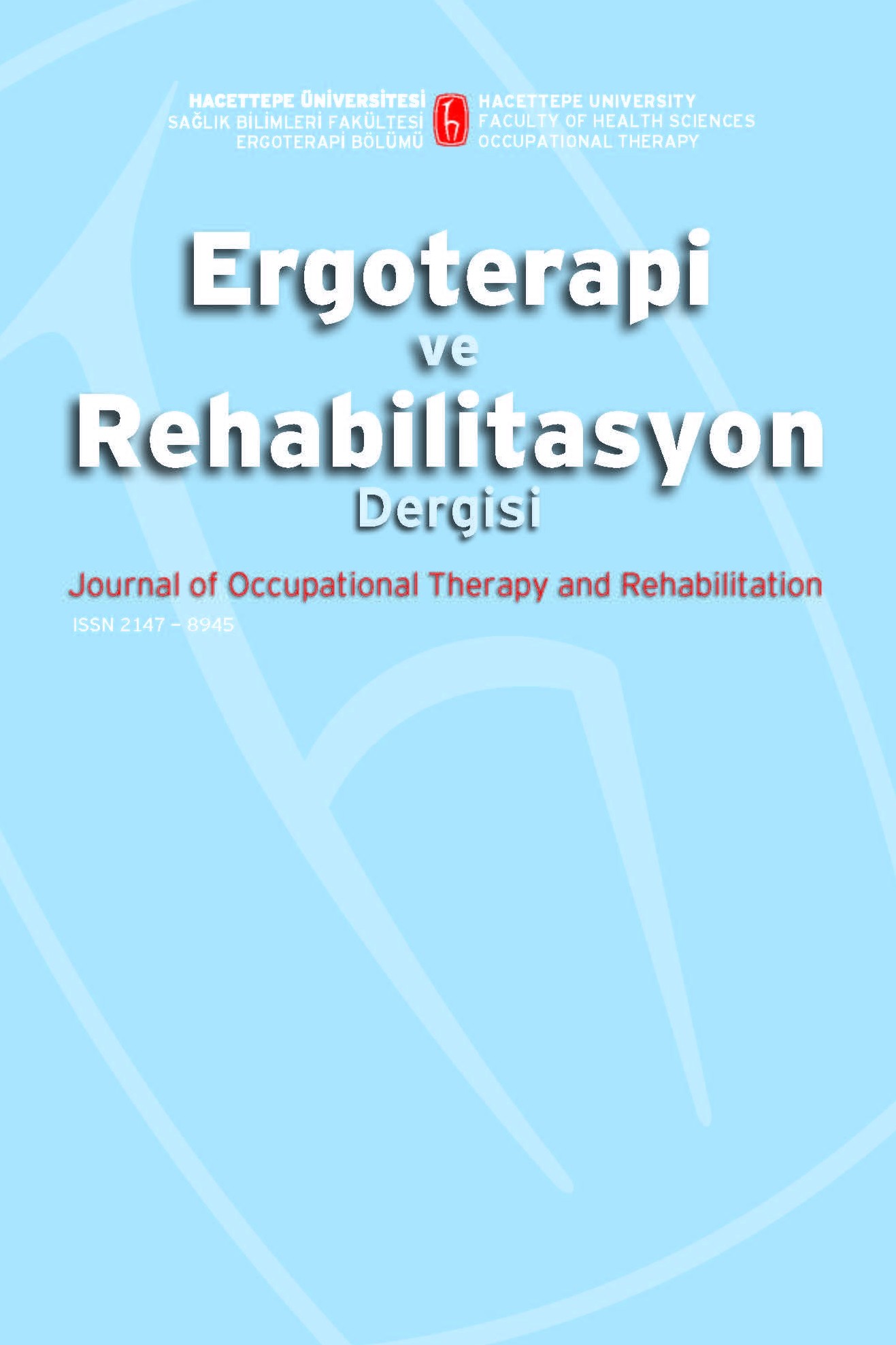Farklı Sosyoekonomik Düzeylerdeki Çocuklarda Görsel Algılama Becerileri
Visual Perception Skills Among Children of Different Socioeconomic Status
___
- Ayoub, C., O’connor, E., Rappolt-Schlictmann, G., Vallotton, C., Raikes, H., & Chazan-Cohen, R. (2009). Cognitive skill performance among young children living in poverty: Risk, change and promotive effects of Early Head Start. Early Childhood Research Quarterly, 24, 289-305. doi:10.1016/j.ecresq.2009.04.001
- Bowman, O. J., & Wallace, B.A. (1990). The Effect of Socioeconomic Status on Hand Size and Strength, Vestibular Function, Visuomotor Integration and Praxis in Preschool Children. The American Journal of Occupational Therapy, 44(7), 610-620.
- Bradley, R.H., & Corwyn, R.F. (2002). Socioeconomic status and child development. Annual Review of Psychology, 53,371-399. doi:10.1146/annurev.psych.53.100901.135233
- Brown, T., & Elliott, S. (2011). Factor structure of the MotorFree Visual Perception Test-3rd edition (MVPT-3). Canadian Journal of Occupational Therapy, 78, 26–36. Bulletin of the Confederation of Turkish Trade Unions, February 2014. Retrieved from http://www.turkis.org.tr/dosya/MAY1RsoddqWy.pdf
- Butun Ayhan, A., Aki, E., Mutlu, B., & Aral, N. (2015). A Study of Conceptual Development and Visual Perception in SixYear-Old Children. Perceptual & Motor Skills, 121(3), 832-839. doi:10.2466/24.10.PMS.121c22x7
- Christensen, D. L., Schieve, L. A., Devine, O., & DrewsBotsch, C. (2014). Socioeconomic status, child enrichment factors, and cognitive performance among preschool-age children: Results from the Follow-Up of Growth and Development Experiences study. Research in Developmental Disabilities, 1-13. doi:10.1016/j.ridd.2014.02.003
- Colarusso, R. P. & Hammil, D.M. (2003). Motor-Free Visual Perception Test, Third Ed. California, Academic Therapy Publications.
- Evans, G. W., & Kantrowitz, E. (2002). Socioeconomic status and health: the potential role of environmental risk exposure. Annual review of public health, 23(1), 303-331.
- Farah, M. J., Shera, D. M., Savage, J. H., Betancourt, L., Giannetta, J. M., Brodsky, N. L., et al. (2006). Childhood poverty: Specific associations with neurocognitive development. Brain Research, 1110, 166-174. doi:10.1016/j.brainres.2006.06.072
- Forns, J., Torrent, M., Garcia-Esteban, R., Cáceres, A., Pilar Gomila, M., Martinez, D., et al. (2012). Longitudinal association between early life socio environmental factors and attention function at the age 11 years. Environmental Research, 117, 54 –59. doi:10.1016/j.envres .2012.04.007
- Hackman, D. A., & Farah, M. J. (2009). Socioeconomic status and the developing brain. Trends in Cognitive Sciences, 13(2), 65-73. doi:10.1016/j.tics.2008.11.003.
- Macintyre, S., Macdonald, L., & Ellaway, A. (2008). Do poorer people have poorer Access to local resources by area deprivation in Glasgow, Scotland. Social Science & Medicine,67(6),900-914. doi:10.1016/j.socscimed.2008.05.029
- Metin, Ş., & Aral, N. (2013). Motor beceriden bağımsız görsel algı testi-3: Geçerlik güvenirlik çalışması. Çankırı Karatekin Üniversitesi Sosyal Bilimler Enstitüsü Dergisi, 4(2), 57-72.
- Newell, T. G., Herdtner, T. J., & Lough, L. (1968). Perceptual and socio-economic variables, instruction in bodyorientation, and predicted academic success in young children. Perceptual and Motor Skills, 26, 1175-1184. doi: 10.2466/pms.1968.26.3c.1175
- Noble, K. G., Farah, M. J., & Mccandliss, B.D. (2006). Socioeconomic background modulates cognitionachievement relationships in reading. Cognitive Development, 21, 349-368. doi: 10.1016/j.cogdev.2006.01.007
- Noble, K.G., Norman, M. F., & Farah, M.J. (2005). Neurocognitive correlates of socioeconomic status in kindergarten children. Developmental Science, 8(1), 74- 87. doi:10.1016/S0013-4694(97)95213-9
- Ochi, M., Fujiwara, T., Mizuki, R., Kawakami, N., & World Mental Health Japan Survey Group. (2014). Association of socioeconomic status in childhood with major depression and generalized anxiety disorder: results from the World Mental Health Japan Survey 2002-2006. BMC Public Health, 14, 359. doi:10.1186/1471-2458-14-359
- Otero, G. A. (1997). Poverty, cultural disadvantage and brain development: a study of pre-school children in Mexico. Electroencephalography and Clinical Neurophysiology, 102, 512-516. doi:10.1016/S0013-4694(97)95213-9 Pienaar, A. E., Barhorst, R., & Twisk, J. W. (2013).
- Relationships between academic performance, SES school type and perceptual-motor skills in first grade South African learners: NW-CHILD study. Child Care Health and Development, 40(3), 370-378. doi:10.1111/cch.12059
- ISSN: 2147-8945
- Yayın Aralığı: Yılda 3 Sayı
- Başlangıç: 2013
- Yayıncı: Hacettepe Üniversitesi Sağlık Bilimleri Fakültesi
Öznur BÜYÜKTURAN, Buket BÜYÜKTURAN, Fatmanur Aybala Meral KOÇAK
Visual Perception Skills Among Children of Different Socioeconomic Status
Hatice ABAOĞLU, Babak KASHEFIMEHR, Gülfer KATIRCIBAŞI, Esra AKI
Farklı Sosyoekonomik Düzeylerdeki Çocuklarda Görsel Algılama Becerileri
Esra, AKI, Hatice ABAOĞLU, Gülfer KATIRCIBAŞI, Babak KASHEFIMEHR
Rehabilitasyon Çalışanlarının Aile İşlevselliğine Yönelik Görüşleri Üzerine Nitel Bir Çalışma
Sensory-Motor-Cognitive Functions in Preschool Children with Autism Spectrum Disorder
Mustafa ULUYOL, Mehmet YANARDAĞ
Goalball Sporcularında Ayakkabının ve Görmenin Denge Üzerine Etkisinin İncelenmesi
Bihter AKINOĞLU, Tuğba KOCAHAN, Tuğba BİRBRN, Necmiye ÜN YILDIRIM, Adnan HASANOĞLU, Gülcan KARAMAN
Okulöncesi Otizm Spektrum Bozukluğu Olan Çocuklarda Duyu-Motor-Biliş Fonksiyonları
